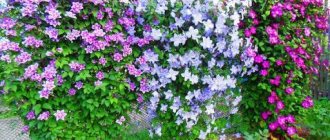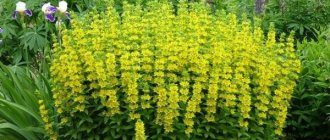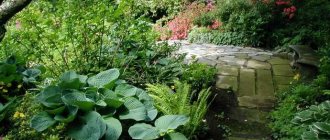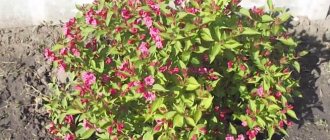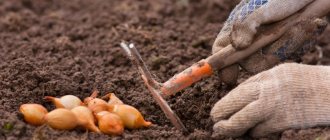Caring for and growing a hosta flower is not a difficult task, but it requires care and diligence.
Hosta is called the “queen of shadow”. This is a plant that can do without bright sun and at the same time delight the gardener with its appearance. Dear readers!
For you, we have created communities on social networks in which useful articles and interesting ideas are published several times a day! Subscribe and receive useful content in a convenient format! In this article we will talk about everything you need to know to grow this plant. You will also find photos of planting and caring for a hosta flower.
What a hosta looks like, description
Hosta is a herbaceous plant, a rather large and lush shrub with beautiful lanceolate or rounded leaves. They grow from the root and are petiolate. Depending on the variety, they differ in color (solid, variegated) and shade of the leaf blades.
The inflorescences are racemose, but not too decorative. Hosta is more valued for its leaves. They are dense, slightly glossy, and may have a textured texture.
Hosta is characterized by increased shade tolerance, resistance to frost and love for abundant watering. All this makes the plant the “queen of shade”, a flower that easily takes root in the most sun-deprived areas of the garden.
ON A NOTE. The second name of the plant is “funcia”. But it almost did not take root in the Russian-speaking community of flower growers.
How to transplant correctly
If you need to move an adult bush to a new area, before removing it, dig it up on all sides and lift it with a pitchfork along with a lump of earth.
Hosta is bred by dividing from the main plant:
- First, check to see if there are any slugs or damage on the roots.
- The bush is washed and dried.
- Dried parts are cut off with pruning shears.
- Dip into a solution of potassium permanganate.
Seedlings with 2 or 3 rosettes of leaves can be separated from the main plant with a disinfected knife. The sections are treated with a fungicide. The hosta will delight you with its decorative appearance next year.
Features of planting the “Hosta” flower
First of all, let's talk about planting hostas. There are two possible options - plant in spring or autumn before frost. Planting hosta in open ground in the spring is less preferable, but is much more often used by summer residents.
Where and where is it better to plant hosta in the garden?
It is best to plant funkia in a flowerbed where there is partial shade and there are no gusts of wind. It is important to take into account the varietal characteristics of a particular hosta. If your plant has bright foliage, then it can be placed in an area with diffused lighting. But blue-leaved varieties require shade. In the sun, such hosts immediately lose their decorative effect.
Distance between hosts when landing
The distance between the flower and its neighbors depends on the varietal characteristics. Small varieties are planted half a meter apart. Large ones should be left at least 1 m between adjacent hosts.
ON A NOTE. You can increase the distance when planting if you plan to plant other flowers nearby.
What kind of soil does the hosta like when planting, what kind of soil is needed
Funkia is good because it is completely tolerant to any type of soil. But, if you have such an opportunity, then plant on loam with neutral soil acidity. Planting in a flower bed with sandy soils may be interesting. There the growth of the hosta will become slower, but its decorative value will increase.
Flower planting depth
The depth of the planting hole should be selected based on the size of the flower. Start with a hole 30 by 30. If the growth point is below ground level, then add soil; if it is much higher, then dig a little more hole.
What to put in the hole when planting hosta
To ensure that hosta planting in the spring is effective and the plants take root, you can add a little fertilizer to the hole. It is best to add a pinch of azofoska. Experienced summer residents also advise putting a handful of peat.
What flowers to plant hosta with, what can be planted between plants
Despite the fact that the plant can be used to “plug holes” in your garden, every gardener wonders how to plant hostas beautifully.
Hosta has a good neighborhood with ferns and conifers. You can also place daylilies nearby.
Features of care after planting
After planting the hosta in the spring, the plant needs to have the right conditions for growth and development. They include regular and abundant watering, careful and shallow loosening of the soil, fertilizing and mulching of the flower bed.
How to plant hosta in the spring from the store in a bag or containers
Since hosta is a popular plant, many large stores sell the plant in packaging and ready for planting.
If you bought a hosta in a bag or container in a store, then planting it in the garden will be no different from the standard procedure. Except for one thing. You need to very carefully remove the plant from the container so as not to damage the roots.
To do this, moisten the lump of earth and wait a little. You can also carefully cut the container from the side.
Preparing a new site
The land in the garden where the hosta will be grown is cleared of weeds. Sandy soil is diluted with peat. Sawdust, which has already rotted, is added to heavy soil. Depleted soil is fertilized with ash and microelements.
To destroy insect larvae and fungal spores, before planting the perennial, the area is watered with a weak solution of potassium permanganate.
The holes for the plant are dug to a depth of 0.4 m and made wide. An interval of one meter is left between bushes of large varieties of perennials, and 30 cm between dwarf species.
Selecting a location
Hosta loves shade; a spreading and lush perennial grows in such an area. When there are light stripes on the leaves of the bush, you can plant it closer to the sun, but the hosta develops more slowly.
Soil requirement
The ornamental plant takes root in different soils, but loves non-acidic loams and dies in an area where water comes close to the surface. In sandy soil, the hosta blooms profusely, but develops slowly.
Digging
Having chosen a place where the ornamental plant will be comfortable, they remove the debris, rake up the remains of stems and leaves, pull out the weeds by the roots, and dig up the soil using a shovel.
Fertilizer
Before planting a perennial, organic matter is added to the soil. Wood ash is perfect for this purpose; superphosphate or potassium salt is poured into the prepared holes. If the hosta grows in depleted soil, it is fed with mullein and mineral fertilizers three times a season.
Planting hole
The perennial is placed in holes that are dug to a depth of 0.4 m. The roots of the hosta are located horizontally. For tall varieties, a hole is made more than a meter wide, for medium-sized bushes - from 50 to 80 cm, for dwarf species - 20 is enough. Expanded clay or crushed stone is poured into the bottom of the hole, and the drainage layer is covered with humus.
See also
How to transplant irises to another place in the fall, terms and rules for aftercareRead
Features of caring for plants at different times of the year
So, you have a hosta growing in your garden or flower bed. Care and cultivation will be slightly different at different times of the year.
in spring
Hostas are planted in open ground in the spring when the weather permits. Namely, the threat of return frosts must pass, or low temperatures will destroy the plant.
In the spring, the first fertilizing is carried out. It is best to use urea. This way you stimulate the growth of the hosta after winter.
In summer
Caring for the fungus in the summer consists of regular watering and weeding. You also need to trim off old, wilted and dry leaves. You need to loosen the soil under the funk carefully so as not to damage the roots. Peduncles can be removed so as not to spoil the decorative appearance of the plant.
At the same time, fertilizing is carried out with a complex fertilizer made from organic matter and mineral water.
in autumn
Planting and caring for hosta in the open ground continues in the fall. In general, this time of year is considered optimal for rooting new plants. The seedlings will have time to take root before the onset of cold weather, with proper preparation they will survive the winter, and in the spring they will actively begin to grow. Much faster than plants planted after winter.
If you already have a hosta that is ready for wintering, then you need to prune it at the root and cover the rhizome with old leaves, compost, or cover it with agrofibre.
Description and features
A perennial from the Asparagus family was first described by a scientist from Austria and is divided into 4 dozen species, each of which is interesting in its own way. The plant does not have a stem, but has many roots with which the hosta clings to the ground, rocks and gorges. Long peduncles are formed above a rosette collected from leaves separated by stripes, spots, and strokes of white, yellow, and blue shades.
The perennial is grown in a flowerbed next to peonies, combined with irises and lilies, in the garden - under bushes and trees. Hosta flowers are painted in different colors, they are:
In their place a box full of seeds is formed. The bush will grow in height up to 0.8 m, in dwarf varieties - up to 15–20 cm. Hosta is undemanding to the sun, loves shade and moisture.
Hosta propagation in different ways
There are several ways to propagate hosta flowers. Let's take a closer look at them.
How to propagate by rhizome in open ground
Cuttings are carried out at any time during the season. It is necessary to carefully separate the petiole with the bud and rhizome from the bush. The resulting cutting is dropped in and covered with a plastic bottle or cup.
Reproduction by dividing the bush
An old specimen is dug out of the ground. He shakes himself off carefully. To remove all the soil, the rhizome can be soaked in water for several hours. After which the bush is inspected. Sick and damaged areas are treated. Next, the plant is divided into several parts. All cuts must be carefully treated with potassium permanganate and sprinkled with charcoal. Next, each part is planted as a separate plant.
Is it possible to grow hosta from a leaf?
In general, it is possible. But this is a very long and ineffective method. It is better to propagate by dividing the bush or cuttings.
How to propagate seeds
Only true fans of this culture propagate funkia seeds. The fact is that the flower grows weakly. Only 7 out of 10 seeds appear after sowing.
How to plant hosta obtained from seeds in the garden? Exactly the same as ordinary seedlings. First, we sow the grains into the ground and leave them to germinate. Next, we provide the seedlings with proper attention. Then we dive, and once the threat of frost has passed, we transplant into open ground.
Hosta planted in this way grows slowly. Only in the 3rd year can the plant be called a mature adult bush.
In general, this is a rather labor-intensive and controversial method. Especially if you want quick results.
Propagation by cuttings and dividing the bush
The most common methods for obtaining new plants are used when there is at least one bush at the age of 3–5 years. Propagation by cuttings and division is not recommended 1–2 years after planting. During this period, underground and above-ground organs are given the opportunity to strengthen.
Dividing the bush and cuttings allows you to obtain hostas of the same variety as the mother plant.
The best time for propagation by vegetative methods is in the spring, when seedlings appear. The mother plant is carefully dug up, large lumps of soil are shaken off the rhizome, and old and rotten parts are cut off. Cut the hosta with a shovel or sharp knife. Parts of a divided bush must have buds and pieces of root.
Tips and warnings:
- Only healthy plants are divided for planting.
- In the first few weeks, water frequently, but without stagnation of water.
- Hostas grow slowly after transplantation, especially variegated varieties.
- Young leaves in most cases have a uniform green color.
- The characteristics of the variety appear fully after 2 years.
Cuttings - separating a part with buds and a piece of rhizome - can be carried out from spring to autumn. Sometimes the procedure is unsuccessful, there are almost no roots left, but there are buds, or there is no rosette, but there is a rhizome. Even such inferior planting material is not thrown away. The cuttings are planted in the shade and covered with a cut plastic bottle. The missing organs gradually grow back and full-fledged leaves are formed.
Agricultural technology for growing hostas in open ground
Now let’s look at what needs to be done to ensure that the hosta grows well. The flower tolerates care and cultivation even in unfavorable conditions stoically. But this does not mean that you can not monitor it, water it and feed it when necessary.
Watering
Proper watering is the most important thing in proper hosta care. The soil should be slightly moist. The soil should not be allowed to dry out. To retain moisture longer, mulch the bushes.
IMPORTANT! In dry summers, the soil under the hosta should be saturated with moisture up to 15 cm deep.
Feeding schemes
Feeding funkiya is carried out three times a year.
The hosta is fertilized for the first time in the spring. Urea is used for this. The standard recipe for preparing fertilizer is a matchbox in a bucket of water.
The second time the procedure is carried out in the summer. The following fertilizer is suitable: 1 liter of mullein, 10 liters of water, a spoonful of superphosphate and a glass of ash.
The last, third time, fertilizer is applied in the fall. It is better to use ash infusion (a glass of ash in a bucket of water).
ON A NOTE. All root fertilizers are applied after moistening the soil under the funk.
Transfer
Hosta does not really like transplanting. However, sometimes it needs to be done. Both for decorative and practical purposes.
The best time to dig up and place a plant in a new place is autumn. Although rooting is carried out in the spring. In any case, this must be done either after the last morning frost, or 1.5 months before the first cold weather.
Trimming
Hosta often does not need to be pruned. You can do this in the spring for decorative purposes. But in the fall it is necessary to cut off the entire above-ground part.
Bush rejuvenation
Rejuvenation of the bush is carried out during its transplantation. In principle, this procedure can be carried out already 5 years after planting the plant. Although the hosta can grow in one area for almost 20 years.
You need to carry out a rejuvenating transplant when you notice that your plant has begun to lose its decorative appearance.
Possible mistakes when planting hostas in the fall
Sometimes gardeners make mistakes when transplanting hostas. Because of this, the plant cannot take root, does not bloom, and the leaves become small.
- Planting times are not observed. The plant is transplanted either too early or late in the fall. It does not have time to get used to the new place and gets sick, which affects its appearance.
- The planting depth is not maintained. If the plant is buried deeply, the roots cannot rise for a long time. If too close to the surface, the roots dry out or freeze.
- Add fresh manure when transplanting. It promotes root burning.
- Water too much , the plant rots from excess moisture and dies.
- Transplant to the place where another hosta grew.
Proper planting of hostas:
Flowering conditions
The main condition for hosta flowering is the presence of diffused light or at least partial shade. It is then that the plant will release flower stalks. Therefore, every gardener must decide why he plants hosta in his garden: for the sake of beautiful decorative leaves or for the sake of flowers?
How to care after flowering?
A responsible summer resident should have a question: what to do when the hosta flowers fade? Plant care continues.
First , remove the flower stalks so that they do not waste the plant’s energy.
Secondly , mulch the soil.
Thirdly , increase watering.
Fourthly , if necessary, replant and propagate the plant.
Preparing for winter
It is necessary to cover the hosta for the winter after replanting to protect the root system from frost. In regions with warm winters, it is enough to mulch the soil and lightly hill up the bush, but where the winters are cold, you need to build a shelter. All preparatory stages should be carried out in dry weather.
Preparation stages:
- cut off dry leaves (peduncles must be cut before replanting);
- Spud the bush (low) with dry soil;
- pour a layer of mulch (sawdust, peat, dry grass) near the bush;
- to protect against slugs and pests in the spring, it is recommended to treat the bushes with an insecticide and sprinkle with tobacco dust;
- cover the bush with any breathable material, securing it at the edges with a heavy object.
Important! Under the film or roofing felt, the plant begins to rot due to lack of air circulation.
The hosta, transplanted in the fall according to all the rules, will continue to decorate the site for many years, thanking for the attention with neat ornamental bushes and beautiful variegated foliage.
Popular varieties and types of hosta with photos
The popularity of hosta has led to the fact that breeders are actively breeding new varieties. There are many varieties of function known. They differ in the appearance of the bush, but, most importantly, in the structure and structure of the leaf plates. The shapes, texture, color and size of the leaf plates vary.
Below we have provided a brief overview of the most popular types of functions.
White feathers
Quite an interesting variety with creamy leaf blades, which over time become covered with a network of greenish veins.
Podorozhnovaya
It got its name from its foliage, which is very similar to plantain, only much larger in size.
Even the color of the leaf blades of these plants is similar.
Blue
This is not even a single variety, but a whole set of varieties, including Blue Cadet, Canadian Blue, Big Daddy and others.
They are distinguished by a bluish tint of leaves.
Mix
A group of varieties with leaves of different colors.
Does not like transplanting or dividing the bush.
Blue Angel
Tall variety.
The foliage is a rich shade with a bluish tint.
It can spread almost 2.5 m wide.
Atlantis
Used for growing in pots.
Dense bush with yellow-green foliage.
White Fever
Hybrid variety with cream leaves.
Leaves resemble creamy white feathers
Bush height 30-35 cm.
Antiochus
Spreading funkia with lavender flowers.
Foliage is bordered.
Painted in a lighter, light green shade.
August moon
A “classic” variety with wide leaves with a golden tint.
It has pale lilac inflorescences.
Perennial
This is perhaps the most common hosta.
The flower loves moderate care, without bending in one direction or the other.
Albomarginata
Medium-sized bush with dark leaf blades with white edges.
Resistant to pests, extremely unpretentious in cultivation.
T. Rex
Features huge green leaves.
Powerful petioles. Up to 2 m wide.
Mouse ears
A small bush with small concave leaves.
Light veins are clearly visible on the leaf blades.
White Feather
An unusual variety.
The difference is that the leaves are soft white in color, and then form soft green veins.
Albopicta
It has dense leaves of a lightish, almost yellow hue.
Extremely frost-resistant.
Lipstick blonde
The difference is yellow (sometimes bright yellow) leaves with red petioles.
The shape of the leaf blades is rather lanceolate and wavy.
Blue ivory
Wide plant of medium height.
It acquires its most saturated color in the shade.
It has bluish leaves.
Common mistakes
Let's look at the mistakes that summer residents make when growing funkia on their plots.
- Incorrect selection of the place where the hosta will grow. The plant should be planted in partial shade for varieties with bright leaves and in dense shade for dark-leaved varieties;
- Incorrect watering. Funkia loves moisture; if it lacks water, the tips of the hosta's leaves will turn black.
- Arrangement of varieties with dark leaves in the sun. Hosta is a shade plant.
- The plant is not prepared for wintering. Many people forget to prune hostas in the fall. As a result, frost causes significant damage to it, including the death of the flower.
Replanting hostas in the fall
It is better to replant the hosta in the fall at the beginning of the season - September, ideally - before the middle of the month. It takes at least a month for the plant to root. There are even hosta varieties that should only be replanted in the fall, because... In the spring, their roots simply do not grow. These include Tokudam and Siebold hosts. These hostas should only be replanted in the fall.
Before planting, the area is dug up to the depth of a spade bayonet. A couple of hours before planting, the area is watered. Make a hole, pour a mound of fertile soil, add 10-15 g of ammonium nitrate, superphosphate, potassium sulfate. The larger the bush or plot, the larger the planting hole should be. It is advisable to provide good drainage from pebbles or broken bricks. When planting, the roots are placed on the surface of the mound so that there are no voids under them. Fertile soil is poured on top, compacted, and watered abundantly. The plot is placed at the same depth at which the mother plant grew. After planting, the root collar is mulched with humus or peat. Watering is repeated several times every 3-4 days.
If several plants are planted at once, then large varieties should be placed at a distance of a meter, and medium ones - half a meter; for dwarf varieties, a distance of 0.2 meters will suffice.
Answers to popular questions
Below are the most popular questions about hosta planting and care in open ground and the answers to them.
Is it possible to plant hosta in the sun?
There are some varieties (with yellow leaves) that can grow in the sun. But still, in order not to ruin the flower, this plant should be planted in shade or partial shade.
What to plant next to hosta in the shade
If the task is to place the hosta in dense shade, then the best neighbors for the flower will be ferns, which are also not too demanding on lighting.
What to plant next to hostas in the flowerbed, along the fence and path
Since the hosta needs to be planted in the spring only after the last threat of frost has disappeared, it needs to select appropriate neighbors.
Ferns or daylilies look good nearby. You can also place low coniferous plants nearby.
